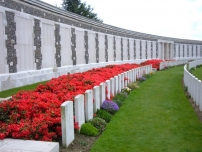| First Name: | William Cecil | Last Name: | ANDREWS | |
|---|---|---|---|---|
| Date of Death: | 24/10/1917 | Lived/Born In: | Bayswater | |
| Rank: | Rifleman | Unit: | King's Royal Rifle Corps9 | |
| Memorial Site: | Tyne Cot Memorial, Belgium | |||
Current Information:Age-24 Born-Notting Hill
Third Battle of Ypres This was a campaign fought between July and November 1917 and is often referred to as the Battle of Passchendaele, a village to the north-east of Ypres which was finally captured in November. It was an attempt by the British to break out of the Ypres salient and capture the higher ground to the south and the east from which the enemy had been able to dominate the salient. It began well but two important factors weighed against them. First was the weather. The summer of 1917 turned out to be one of the the wettest on record and soon the battlefield was reduced to a morass of mud which made progress very difficult, if not impossible in places. The second was the defensive arrangements of concrete blockhouses and machine gun posts providing inter-locking fire that the Germans had constructed and which were extremely difficult and costly to counter. For 4 months this epic struggle continued by the end of which the salient had been greatly expanded in size but the vital break out had not been achieved. On 10-11th October, 1917, 14th Division relieved 5th Division between the Menin road and Polygon Wood and on 16th October, 9th King’s Royal Rifle Corps of 42 Brigade, moved into the front line opposite Polderhoek chapel. Here they remained for eight days, a particularly long tour given the trying conditions of mud and continuous shelling, some of which was ‘friendly fire’. The support line and Battalion HQ took the brunt of this onslaught as the opposing front lines were too close to each other, only 25 yards apart in some places, to be targeted by either side. Many of the shells fired were gas shells, both mustard gas and lachrymatory (tear gas).The Battalion Diary gives a very full and readable description of the time spent in these positions. It mentions “a very bad piece of marshland between Battalion HQ and the support line, which has been nearly converted into a lake by the shelling and which renders the duties of runners at night and stretcher bearers as appalling tasks”. It also goes into the problems of communication and concludes that pigeons were too slow and always insisted in flying into the officer’s latrine from where they refused to budge until forcibly ejected. Lamp signalling at night was of limited success and depended on the watchfulness of the receiving signallers and concludes that the only really satisfactory method was runners but that that was a very nasty journey over 350 yards of sticky bog and water. Given the ferocity of the shelling, not to mention the ever present danger of snipers, it is not surprising that 9th King’s Royal Rifle Corps suffered many casualties during their eight days here. One of these was William Andrews who was killed on 24th October. |
||||
| « Back to Search Results | ||||
| If you think any of the information shown here is incorrect, Click Here to submit your amends and comments | ||||




